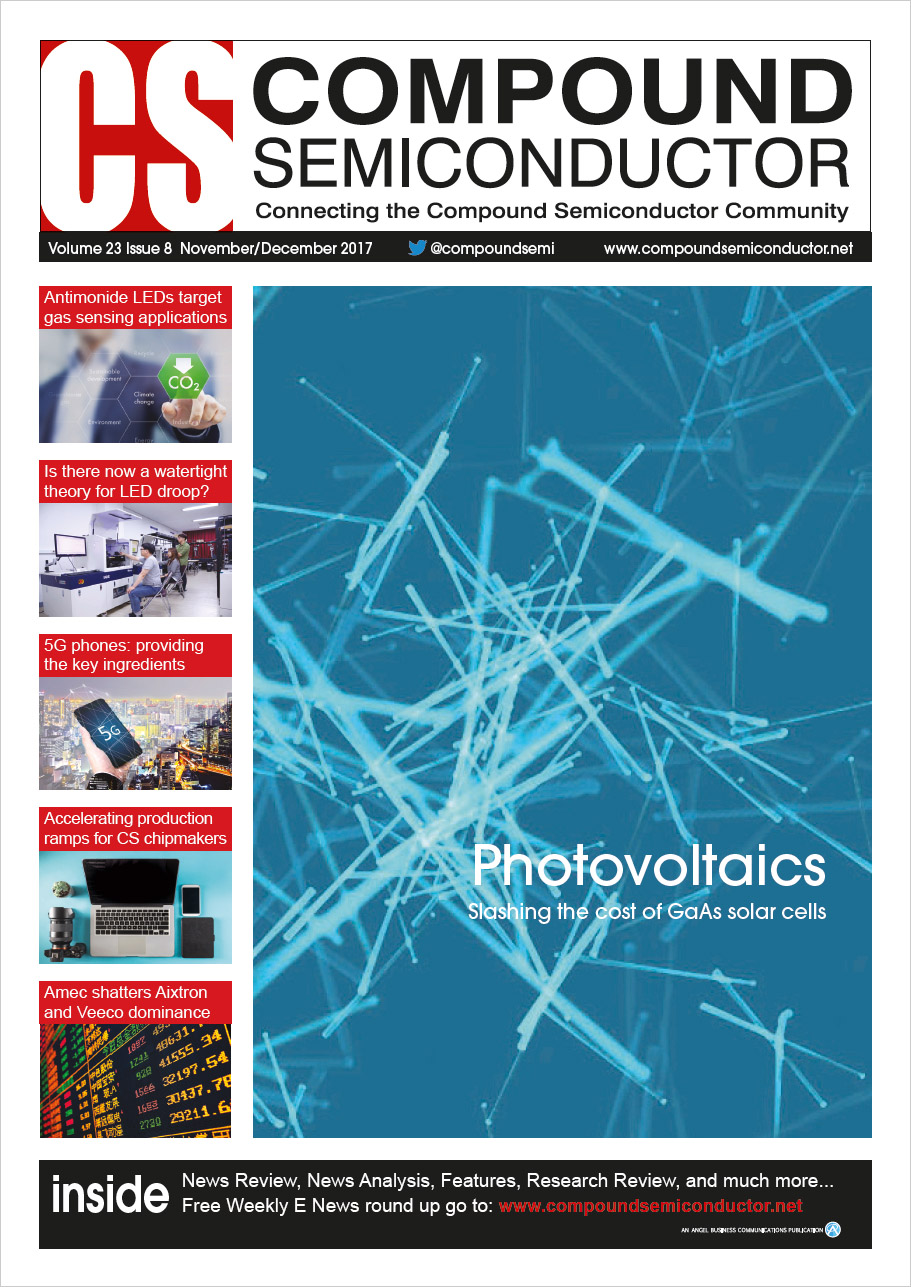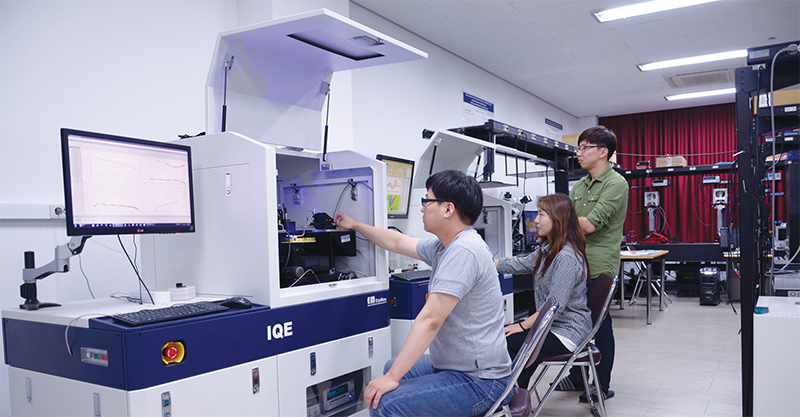
LED droop the role of saturation

Saturation of the radiative recombination rate is the primary cause of droop, according to differential carrier lifetime measurements by Dong-Soo Shin and Jong-In Shim from Hanyang University
When designers incorporate LEDs into their products, they need to know the output power of these devices. In an ideal world, they would then select an LED with an efficiency that peaks at this power. But in practice that's not possible for LEDs emitting in the white, blue and green. With these devices "“ made from GaN and its related alloys "“ the internal quantum efficiency peaks at a relatively low current density, and when the current is cranked up to a value needed to ensure a suitable output power for a particular application, efficiency falls, dragged down by a malady known as droop.
Fathoming the origin of droop will help to combat it and yield better LEDs. For that reason, many researchers have been trying to unveil its origin.
They have offered many different proposals, leading to lively debate. Strong contenders for the cause of droop include: carrier overflow, enhanced by the internal polarization field; carrier delocalization from indium-rich regions and non-radiative recombination at high defect sites; and, most notably, Auger recombination.
This debate on droop has been going on for more than a decade. But any consensus on the cause of droop remains elusive, because the proposed mechanisms fail to explain all the experimental droop phenomena comprehensively and consistently.
What unites all of the conjectures named above is that droop is accounted for as an additional increase in the non-radiative recombination rate. What is ignored is the possibility that the radiative recombination rate is altered by increases in current density.
One of the features of non-radiative electron-hole recombination processes is that they transfer the excess electron energy to particles other than photons. In the case of direct Auger recombination, the process excites electrons or holes to higher energy levels within the same band. The theoretical probability of this Auger process decreases exponentially with both increasing bandgap energy and decreasing operating temperature.
Figure 1. (a) Radiative and non-radiative carrier lifetimes and (b) radiative recombination coefficient B against the injection current, extracted from combined differential carrier lifetime and internal quantum efficiency measurements. The fitting curve for the radiative recombination coefficient uses the theoretical formulation of the phase-space filling, given by B(n)=B0[1+αn]-1. The fitting parameters of B0 = 5à—10-11 cm3s-1 and α = 1à—10-19 cm3 fit the experimental result very well.
Due to this behaviour, there has been doubt over whether Auger recombination can have an impact in III-nitride semiconductors. However, experimental efforts have yielded similar efficiency droop curves in resonant photoluminescence and electroluminescence, adding weight to the claim that Auger recombination is the dominant non-radiative mechanism behind efficiency loss at high carrier densities.
Many groups have estimated the extent of the impact of Auger recombination by using the well-known ABC model in the semiconductor carrier rate equation. This had led to reports of room-temperature Auger coefficients in InGaN-based LEDs ranging from 3.5 x 10-31 cm6/s to 3.2 x 10-29 cm6/s. In comparison, theoretical values are generally smaller, spanning about 10-34 -10-30 cm 6/s.
Figure 2. The consequences of the saturated radiative recombination rate.
With just one fitting process, obtaining exact values for the A, B, and C parameters simultaneously is not easy. Consequently, it is common practice to fit the A and B coefficients in the low current injection regime and the C coefficient in the high current injection regime. With this approach, the influence of carrier leakage is neglected "“ or, to look at it another way, the injection efficiency is considered as unity. However, resonant photoluminescence eWith just one fitting process, obtaining exact values for the A, B, and C parameters simultaneously is not easy. Consequently, it is common practice to fit the A and B coefficients in the low current injection regime and the C coefficient in the high current injection regime. With this approach, the influence of carrier leakage is neglected "“ or, to look at it another way, the injection efficiency is considered as unity. However, resonant photoluminescence experiments suggest that many carriers can overflow the active region, rather than recombining within the quantum wells.
Saturation effects
Our team at Hanyang University in Ansan, Korea, has recently proposed an alternative mechanism for droop: saturation of the radiative recombination rate, and the subsequent increase of the non-radiative recombination rate. This conjecture is able to explain droop more comprehensively, including its temperature dependence.
A key piece of evidence supporting our view of droop is our observation of a decline in the open-circuit voltage of the LED when this device is cooled to cryogenic temperatures, operated as a solar cell, and subjected to increases in incident optical power. The temperature-dependent behaviour of the open-circuit voltage is quite similar to that of the internal quantum efficiency, and can only be explained by carrier overflow.
As explained before, the majority of proposals for droop are based on the non-radiative recombination rate increasing faster than the radiative recombination rate. If that's the case, combatting droop involves unmasking the important non-radiative recombination processes and eliminating them.
However, it is our view that droop results from the radiative recombination rate increasing more slowly than the non-radiative recombination rate. That may appear to be no different from the previous explanation "“ but it is. That's because the emphasis has shifted from the additional increase in the non-radiative recombination rate, while ignoring any changes in the rate of the radiative recombination, to a focus on a saturation in the radiative recombination rate at high carrier density. Once carriers are saturated, they accelerate the non-radiative recombination rate. To combat droop caused by this, there is a need to increase the radiative recombination rate so that it doesn't saturate, even at high current densities.
We unveiled the cause of droop by undertaking differential carrier lifetime measurements, which reveal the carrier recombination dynamics within the LED. Determining the differential carrier lifetime offers an insight into the total recombination rate, which is the sum of the radiative and non-radiative recombination rates. Once the differential carrier lifetime and the internal quantum efficiency are known, radiative and non-radiative recombination rates can be determined, and carrier dynamics within the device known.
Our experiments have been undertaken on blue LEDs, grown by MOCVD on a c-plane sapphire substrate. These devices feature an AlGaN electron-blocking layer and an active region with five In0.15Ga0.85N wells separated by GaN barriers. The wells emit at 450 nm at 300 K. Device fabrication involves extracting 200 μm by 800 μm chips from the epiwafer, adding lateral electrodes, and housing the resultant structure in a surface-mount-device package.
We are able to determine the differential carrier lifetime from just electrical measurements. Small-signal impedance is measured as a function of driving current, using an Agilent 4294A impedance analyser. By adopting the four-terminal-fixture method for calibration, we ensure accurate impedance values over a frequency range spanning 40 Hz to 110 MHz.
The internal quantum efficiency of our LEDs is determined by conventional temperature-dependent electroluminescence measurements. This approach, which is used by many groups, exploits the "˜freezing out' of non-radiative recombination centres in the active region at cryogenic temperatures. To obtain the internal quantum efficiency at room temperature, we first find the maximum intensity for electroluminescence at the lowest cryogenic temperature "“ in our case, 25 K "“ and then assume that the internal quantum efficiency in those conditions is 100 percent.
Normalising the data reveals that at 300 K, internal quantum efficiency peaks at about 78 percent at 3 A cm-2. Increase the current density and the internal quantum efficiency rapidly decreases, as expected. Light extraction efficiency is estimated to be 65 percent. Note that this value, and that for the internal quantum efficiency, are typical for blue LEDs.
These measurements have enabled us to determine radiative and non-radiative carrier lifetimes as a function of drive current (see Figure 1 (a)). We have also determined the radiative recombination coefficient, and fitted the data with a formula that takes into account phase-space filling (see Figure 1(b)).
Our results allow us to conclude that phase-space filling is behind the saturation of radiative recombination. They also reveal that the non-radiative carrier lifetime has a constant value in the current range 10-5 - 10-3 A, before gradually decreasing as the driving current increases further. In the low current regime, the non-radiative carrier lifetime varies very little, due to Shockley-Read-Hall non-radiative recombination in the active region "“ this is represented by A in the rate equation. However, when the carrier density in the active region reaches a certain value, the carrier injection rate exceeds the carrier recombination rate, due to saturation of the radiative recombination rate. Once this happens, carriers leak out (or overflow) from the active region, inducing a rapid decrease in the non-radiative carrier lifetime, and leading to the onset of droop. Note that the non-radiative carrier lifetime is shortened, due to the establishing of an additional non-radiative recombination path at the p-GaN clad layer.
Further evidence for the role of saturation of the radiative recombination rate as the primary cause of droop comes from measurements of forward voltage as a function of drive current. Using data for internal quantum efficiency, we separate the non-radiative recombination current from the total current. This reveals that the non-radiative recombination current exhibits a peculiar behaviour: we call it the space-charge-limited current. Instead of observing a typical ohmic current, we find that the current is proportional to the voltage squared. That indicates that electrons are not consumed efficiently within the active layer, but overflow to the p-clad layers. The overflown carriers eventually lead to an increase in the forward voltage, observed in the current-voltage characteristics.
Note that if the Auger recombination were the dominant non-radiative recombination behind droop, this kind of behaviour would not be seen, because all the carriers would be consumed efficiently in the active layer. We believe that the behaviour of LEDs at increasing drive currents involves saturation of the radiative recombination rate, causing carriers to pile up and non-radiative recombination to be induced more severely. The upshot of this is seen in the efficiency droop and the forward voltage increase (see Figure 2 for a pictorial summary).
So how can we combat droop? We know that it is caused by saturation of the radiative recombination rate via phase-space filling, which triggers carrier overflow. So, since high carrier densities induce the phase-space filling, one solution is to increase the effective active volume. As the active volume is reduced by piezoelectric fields, asymmetric carrier distributions and potential fluctuations, all three of these factors must be considered when attempting to diminish droop.































